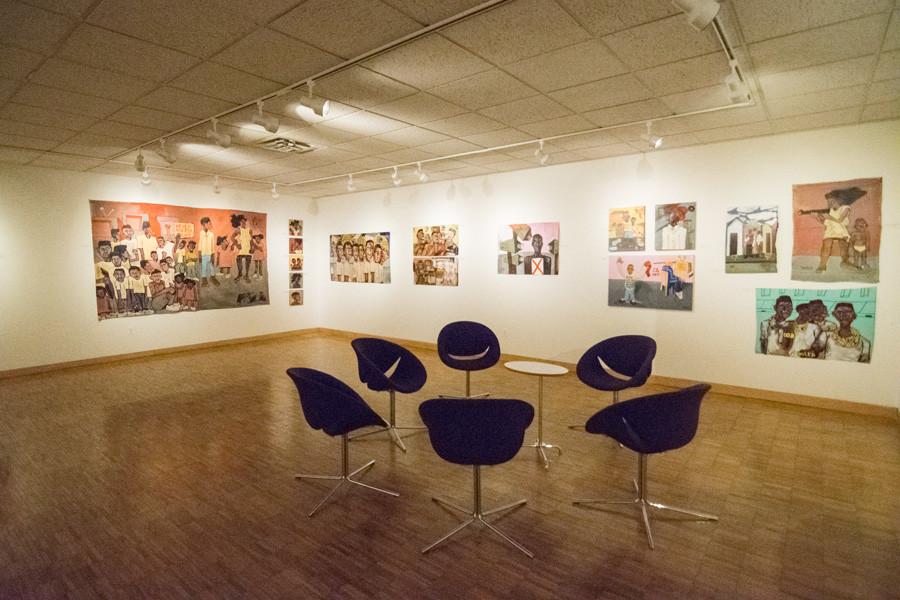Dittmar exhibit seeks to spread awareness of modern day segregation
Courtney Morrison/The Daily Northwestern
Chicago-based artist Marcellous Lovelace’s paintings spread messages about social injustice. His art will be presented at the Dittmar Gallery for the next month.
February 18, 2016
A&E
In a vibrant display of African-influenced art, the Dittmar Gallery’s new exhibit reflects the injustices inflicted upon black communities.
The exhibit features Chicago-based artist Marcellous Lovelace’s work and celebrates Black History Month, Dittmar graduate assistant Federico Arroyo said.
Lovelace’s art portrays the struggles of segregation and poverty that stem from modern-day racism, Lovelace said. The exhibit, ““#Biko70 Lumumba Blacker than Space,” draws from his experiences growing up in a low-income neighborhood in Chicago’s South Side.
“The message of my work is a message of resistance from oppression against colored people all over the world,” Lovelace said. “I think from the perspective of people facing a hard time … it’s like a revolutionary stance.”
Lovelace said his art represents the problems he sees within his life. Many of his paintings are influenced by African art, he said.
“I see people getting shot, killed, robbing from each other, neglected on purpose by oppression and racism,” Lovelace said. “I paint it, either to the best of my ability or how I feel. I feel like I’m painting a desperate person.”
Lovelace talked about issues of gentrification and American education when referring to his art and called Chicago a “gentrification station” that leaves poorer, black families without homes. The artist said the red X’s in his paintings represent buildings that are condemned to be torn down for wealthier individuals. In front of these condemned buildings, crowds of black protesters hold signs that say, “America teaches us poverty.”
Other pieces in the exhibit show Lovelace’s critique of the current education system in America. Groups are shown protesting and in one piece a sign reads, “America teaches us poverty.”
“This exhibit is a little more extreme, and he doesn’t really hold back,” Arroyo said.
Lovelace’s critique of American education comes from his own negative experiences with the system, he said. He said he struggled to finish college due to financial circumstances and has faced racism because of his artistic style. He recalled that one of his professors told him “black art is not real art.”
Despite this discouragement, Lovelace has continued to paint. For this exhibit, he developed more than 400 mixed media images from any material he had access to. Many of his paintings are made of a combination of cardboard, spray paint and markers, Lovelace said. Although he can afford traditional canvas, he prefers to use a mixed medium to reflect the resourcefulness that is necessary to survive in poverty, he said.
Medill senior Michael Odom visited the exhibit and said the messages and narratives of modern-day racism in Lovelace’s work are clear.
“It points to the necessity of black liberation,” he said.
Lovelace described his work as a means to reflect the harsh reality he faces on a daily basis.
“I don’t look at art as a way to escape anything,” Lovelace said. “I look at it as a way to explain existence on Earth. It’s more of a documentation of my life. … When I do art, I’m just painting from my heart and painting from what I know.”
This story has been updated to clarify that Marcellous Lovelace created more than 400 works of art for the Dittmar Gallery’s new exhibit.
This article was updated to clarify Marcellous Lovelace’s comments.
Email: [email protected]


